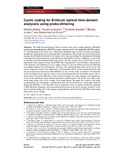Mostrar el registro sencillo del ítem
Cyclic coding for Brillouin optical time-domain analyzers using probe dithering
| dc.creator | Iribas Pardo, Haritz | es_ES |
| dc.creator | Loayssa Lara, Alayn | es_ES |
| dc.creator | Sauser, Florian | es_ES |
| dc.creator | Llera, Miguel | es_ES |
| dc.creator | Le Floch, Sébastien | es_ES |
| dc.date.accessioned | 2017-05-08T13:22:35Z | |
| dc.date.available | 2018-04-17T23:00:14Z | |
| dc.date.issued | 2017 | |
| dc.identifier.issn | 1094-4087 (Electronic) | |
| dc.identifier.uri | https://hdl.handle.net/2454/24232 | |
| dc.description.abstract | We study the performance limits of mono-color cyclic coding applied to Brillouin optical time-domain analysis (BOTDA) sensors that use probe wave dithering. BOTDA analyzers with dithering of the probe use a dual-probe-sideband setup in which an optical frequency modulation of the probe waves along the fiber is introduced. This avoids non-local effects while keeping the Brillouin threshold at its highest level, thus preventing the spontaneous Brillouin scattering from generating noise in the deployed sensing fiber. In these conditions, it is possible to introduce an unprecedented high probe power into the sensing fiber, which leads to an enhancement of the signal-to-noise ratio (SNR) and consequently to a performance improvement of the analyzer. The addition of cyclic coding in these set-ups can further increase the SNR and accordingly enhance the performance. However, this unprecedented probe power levels that can be employed result in the appearance of detrimental effects in the measurement that had not previously been observed in other BOTDA set-ups. In this work, we analyze the distortion in the decoding process and the errors in the measurement that this distortion causes, due to three factors: the power difference of the successive pulses of a code sequence, the appearance of first-order non-local effects and the non-linear amplification of the probe wave that results when using mono-color cyclic coding of the pump pulses. We apply the results of this study to demonstrate the performance enhancement that can be achieved in a long-range dithered dual-probe BOTDA. A 164-km fiber-loop is measured with 1-m spatial resolution, obtaining 3-MHz Brillouin frequency shift measurement precision at the worst contrast location. To the best of our knowledge, this is the longest sensing distance achieved with a BOTDA sensor using mono-color cyclic coding. | en |
| dc.description.sponsorship | H. Iribas and A. Loayssa wish to acknowledge the financial support of the Spanish Ministerio de Economía y Competitividad through the projects TEC2013-47264-C2-2-R and TEC2016- 76021-C2-1-R, FEDER funds and the Universidad Pública de Navarra. | en |
| dc.format.mimetype | application/pdf | en |
| dc.language.iso | eng | en |
| dc.publisher | Optical Society of America | en |
| dc.relation.ispartof | Optics Express Vol. 25, Issue 8, pp. 8787-8800 (2017) | en |
| dc.rights | © 2017 Optical Society of America. Users may use, reuse, and build upon the article, or use the article for text or data mining, so long as such uses are for non-commercial purposes and appropriate attribution is maintained. All other rights are reserved. | en |
| dc.subject | Fiber optics sensors | en |
| dc.subject | Scattering, stimulated Brillouin | en |
| dc.title | Cyclic coding for Brillouin optical time-domain analyzers using probe dithering | en |
| dc.type | Artículo / Artikulua | es |
| dc.type | info:eu-repo/semantics/article | en |
| dc.contributor.department | Institute of Smart Cities - ISC | es_ES |
| dc.rights.accessRights | Acceso abierto / Sarbide irekia | es |
| dc.rights.accessRights | info:eu-repo/semantics/openAccess | en |
| dc.embargo.terms | 2018-04-17 | |
| dc.identifier.doi | 10.1364/OE.25.008787 | |
| dc.relation.projectID | info:eu-repo/grantAgreement/MINECO//TEC2013-47264-C2-2-R/ES/ | en |
| dc.relation.projectID | info:eu-repo/grantAgreement/ES/1PE/TEC2016-76021 | en |
| dc.relation.publisherversion | https://doi.org/10.1364/OE.25.008787 | |
| dc.type.version | Versión publicada / Argitaratu den bertsioa | es |
| dc.type.version | info:eu-repo/semantics/publishedVersion | en |


